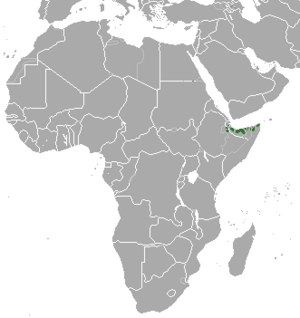Beira (antelope) facts for kids
Quick facts for kids Beira |
|
|---|---|
 |
|
| Conservation status | |
| Scientific classification | |
| Genus: |
Dorcatragus
|
| Species: |
megalotis
|
 |
|
| Beira range | |
| Synonyms | |
|
|
The beira (Dorcatragus megalotis) is a small antelope. It lives in dry, desert-like areas. You can find it in the Horn of Africa. This animal is the only type of antelope in its group, called Dorcatragus.
Contents
What Does a Beira Look Like?
The beira is a small antelope. It has a bushy tail and a rough coat. Its back is reddish-grey. A dark stripe separates this from its white belly. This stripe runs from its front legs to its back legs.
Its long, thin legs are a light brown color. The beira's head is yellowish-red. It has black eyelids and white rings around its eyes. Its ears are very large, about 15 cm long. They are also about 7.5 cm wide. The inside of its ears has white fur.
Only male beiras have horns. These horns are straight spikes. They grow vertically near the ears. They are about 7.5 to 10 cm long. A beira is usually 80 to 86 cm long. It stands 50 to 60 cm tall at the shoulder. It weighs between 9 and 11.5 kg.
Where Do Beiras Live?
Beiras live only in northeast Africa. You can find them in southern Djibouti. They also live across Somaliland and northern Somalia. Some are found in the far northeast of Ethiopia. Most beiras live in Somaliland. Their range extends from Djibouti to Puntland in northern Somalia. They also live in the Nugaal Valley. People only confirmed beiras in Djibouti in 1993.
What Kind of Home Do Beiras Prefer?
Beiras live on rocky or stony hillsides. They like slopes with dry grasslands. These areas often have acacia bushes. Many beira homes are on hills with flat tops. These hills have steep, stony sides.
How Do Beiras Live?
Beiras have been seen giving birth only in April. This is during the peak of the rainy season. A baby beira grows for six months inside its mother. Only one calf is born at a time.
Beiras are most active in the early morning. They are also active in the late afternoon. They rest during the middle of the day. They are very cautious animals. Their excellent hearing helps them notice any small sound. If they sense danger, they move very fast. They can run quickly over loose rocks. They also jump skillfully from rock to rock on steeper ground.
Beiras are used to dry weather. They do not need to drink water. They get all the water they need from the plants they eat. Beiras live in small family groups. These groups always have one male. Sometimes, larger groups are seen. These are probably different family groups meeting up. Beiras mostly eat leaves and twigs from plants. But they will also eat grass if it is available.
Hyenas, caracals, and jackals hunt beiras. If lions and leopards are in the area, they will also hunt beiras.
How Are Beiras Protected?
Some people hunt beiras. But their small size helps them. They are also very cautious. Their rocky homes are hard to reach. These things might help them survive hunting.
Other problems are bigger threats. These include too much grazing by other animals. Droughts also harm them. Cutting down acacia bushes for charcoal is another threat. The IUCN lists the beira as a "Vulnerable" species. This means it could become endangered.
In Djibouti, beiras are rare but not endangered. Their status in Ethiopia is unknown. The last record there was in 1972.
There was only one group of beiras kept in captivity. This was at the Al Wabra Wildlife Preservation. They successfully bred beiras there. The number of beiras reached 58 in 2005.
Where Does the Name "Beira" Come From?
The name 'beira' comes from its name in the Somali language.


